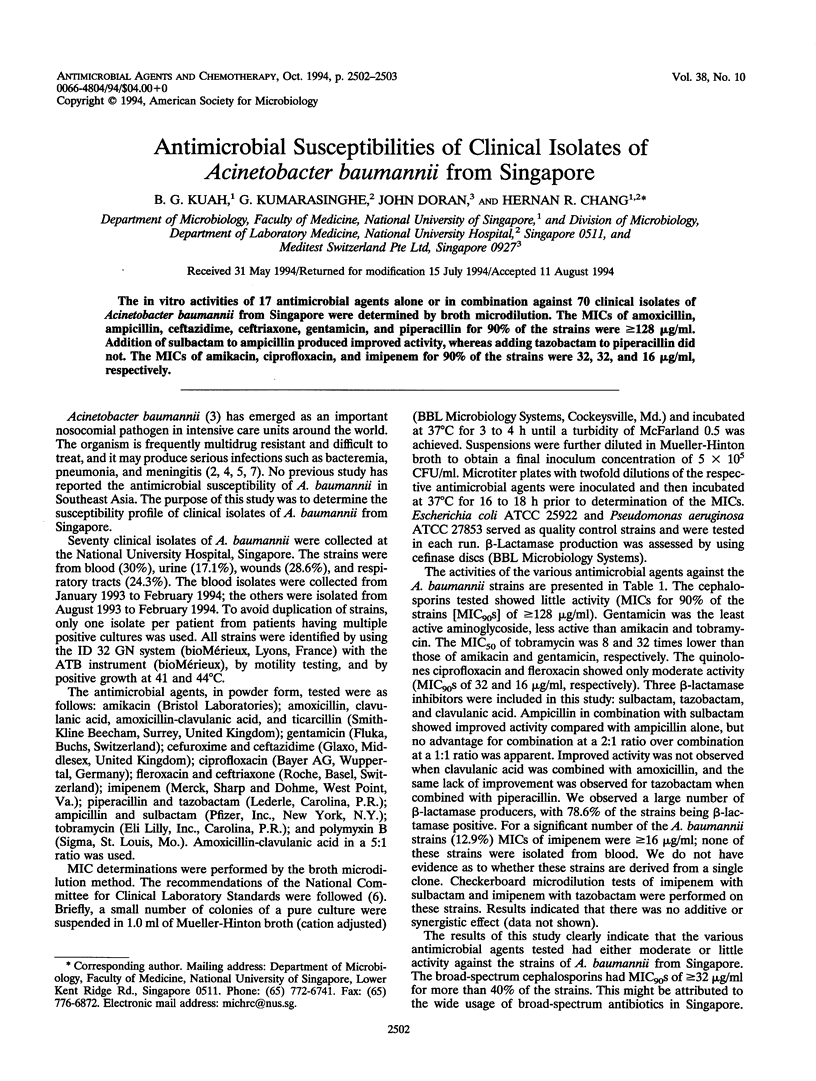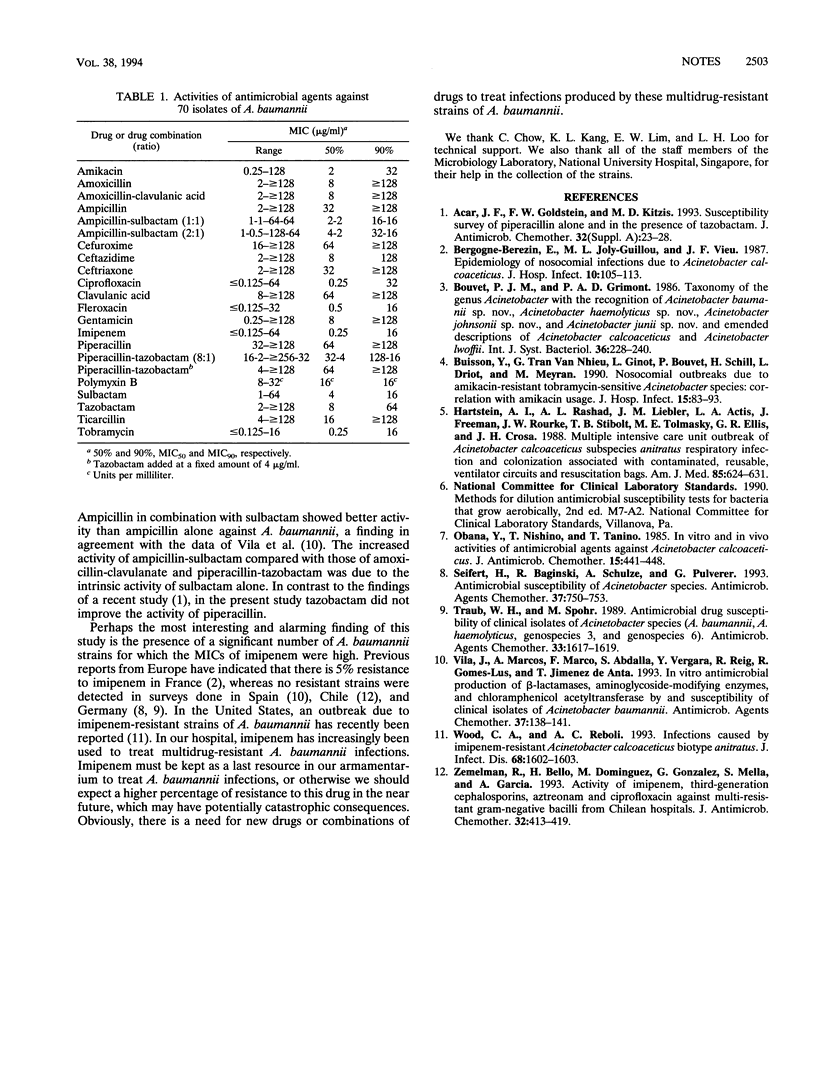Abstract
The in vitro activities of 17 antimicrobial agents alone or in combination against 70 clinical isolates of Acinetobacter baumannii from Singapore were determined by broth microdilution. The MICs of amoxicillin, ampicillin, ceftazidime, ceftriaxone, gentamicin, and piperacillin for 90% of the strains were > or = 128 micrograms/ml. Addition of sulbactam to ampicillin produced improved activity, whereas adding tazobactam to piperacillin did not. The MICs of amikacin, ciprofloxacin, and imipenem for 90% of the strains were 32, 32, and 16 micrograms/ml, respectively.
Full text
PDF

Selected References
These references are in PubMed. This may not be the complete list of references from this article.
- Acar J. F., Goldstein F. W., Kitzis M. D. Susceptibility survey of piperacillin alone and in the presence of tazobactam. J Antimicrob Chemother. 1993 Jan;31 (Suppl A):23–28. doi: 10.1093/jac/31.suppl_a.23. [DOI] [PubMed] [Google Scholar]
- Bergogne-Bérézin E., Joly-Guillou M. L., Vieu J. F. Epidemiology of nosocomial infections due to Acinetobacter calcoaceticus. J Hosp Infect. 1987 Sep;10(2):105–113. doi: 10.1016/0195-6701(87)90135-6. [DOI] [PubMed] [Google Scholar]
- Buisson Y., Tran Van Nhieu G., Ginot L., Bouvet P., Schill H., Driot L., Meyran M. Nosocomial outbreaks due to amikacin-resistant tobramycin-sensitive Acinetobacter species: correlation with amikacin usage. J Hosp Infect. 1990 Jan;15(1):83–93. doi: 10.1016/0195-6701(90)90024-i. [DOI] [PubMed] [Google Scholar]
- Hartstein A. I., Rashad A. L., Liebler J. M., Actis L. A., Freeman J., Rourke J. W., Jr, Stibolt T. B., Tolmasky M. E., Ellis G. R., Crosa J. H. Multiple intensive care unit outbreak of Acinetobacter calcoaceticus subspecies anitratus respiratory infection and colonization associated with contaminated, reusable ventilator circuits and resuscitation bags. Am J Med. 1988 Nov;85(5):624–631. doi: 10.1016/s0002-9343(88)80233-x. [DOI] [PubMed] [Google Scholar]
- Obana Y., Nishino T., Tanino T. In-vitro and in-vivo activities of antimicrobial agents against Acinetobacter calcoaceticus. J Antimicrob Chemother. 1985 Apr;15(4):441–448. doi: 10.1093/jac/15.4.441. [DOI] [PubMed] [Google Scholar]
- Seifert H., Baginski R., Schulze A., Pulverer G. Antimicrobial susceptibility of Acinetobacter species. Antimicrob Agents Chemother. 1993 Apr;37(4):750–753. doi: 10.1128/aac.37.4.750. [DOI] [PMC free article] [PubMed] [Google Scholar]
- Traub W. H., Spohr M. Antimicrobial drug susceptibility of clinical isolates of Acinetobacter species (A. baumannii, A. haemolyticus, genospecies 3, and genospecies 6). Antimicrob Agents Chemother. 1989 Sep;33(9):1617–1619. doi: 10.1128/aac.33.9.1617. [DOI] [PMC free article] [PubMed] [Google Scholar]
- Vila J., Marcos A., Marco F., Abdalla S., Vergara Y., Reig R., Gomez-Lus R., Jimenez de Anta T. In vitro antimicrobial production of beta-lactamases, aminoglycoside-modifying enzymes, and chloramphenicol acetyltransferase by and susceptibility of clinical isolates of Acinetobacter baumannii. Antimicrob Agents Chemother. 1993 Jan;37(1):138–141. doi: 10.1128/aac.37.1.138. [DOI] [PMC free article] [PubMed] [Google Scholar]
- Wood C. A., Reboli A. C. Infections caused by imipenem-resistant Acinetobacter calcoaceticus biotype anitratus. J Infect Dis. 1993 Dec;168(6):1602–1603. doi: 10.1093/infdis/168.6.1602. [DOI] [PubMed] [Google Scholar]
- Zemelman R., Bello H., Dominguez M., Gonzalez G., Mella S., Garcia A. Activity of imipenem, third-generation cephalosporins, aztreonam and ciprofloxacin against multi-resistant gram-negative bacilli isolated from Chilean hospitals. J Antimicrob Chemother. 1993 Sep;32(3):413–419. doi: 10.1093/jac/32.3.413. [DOI] [PubMed] [Google Scholar]


